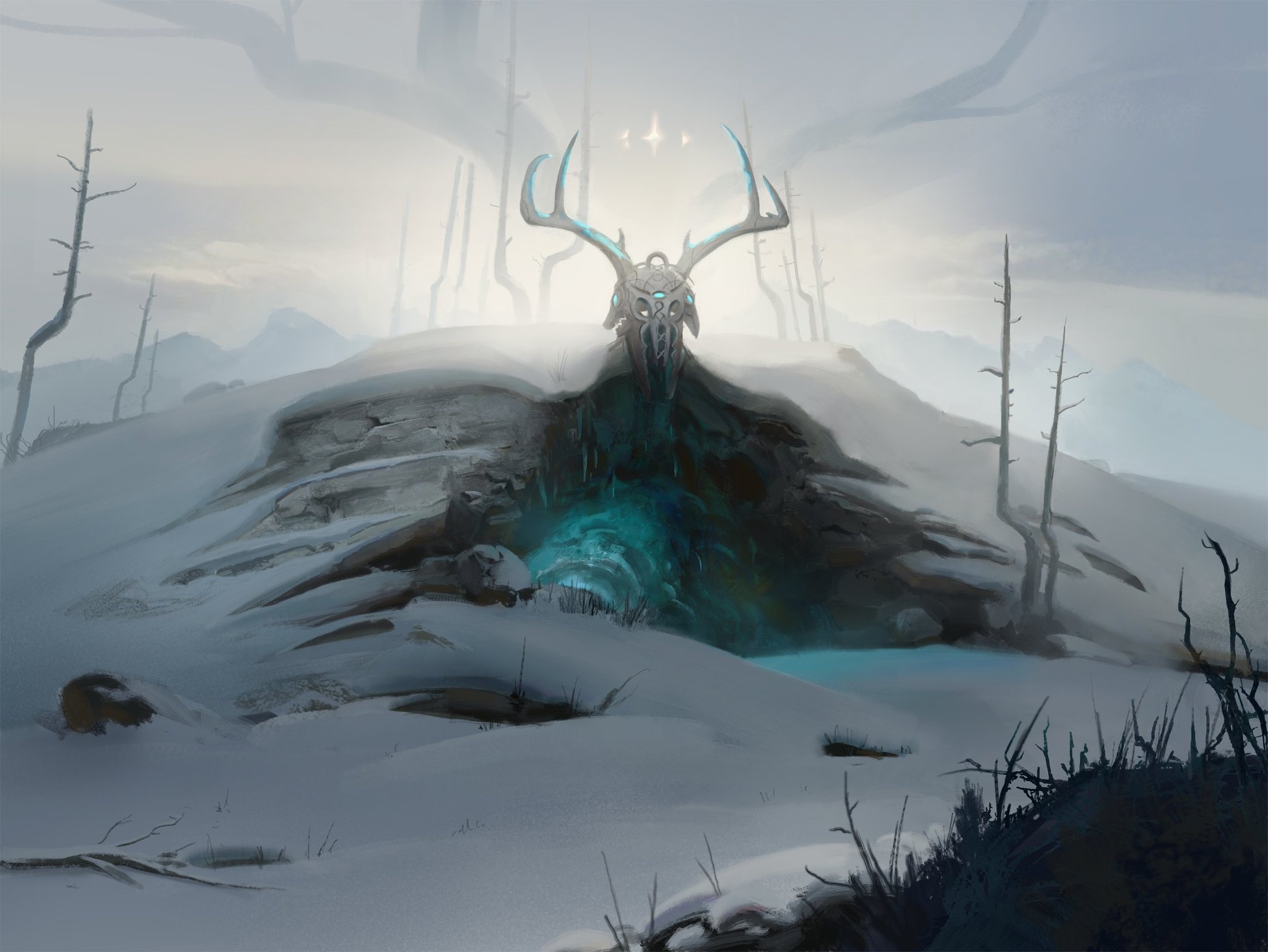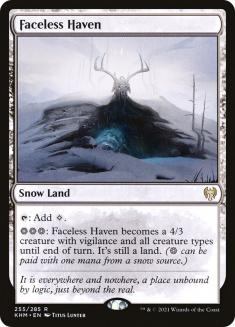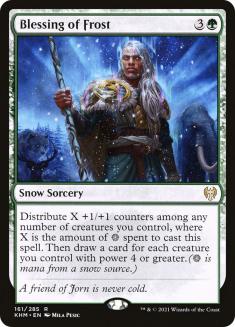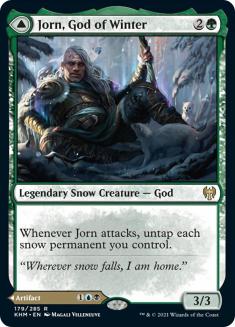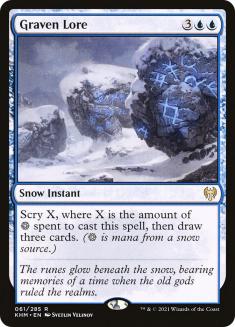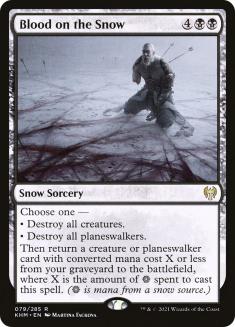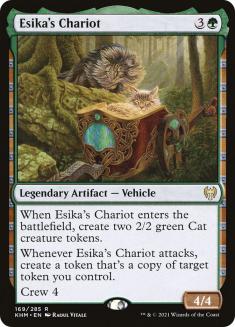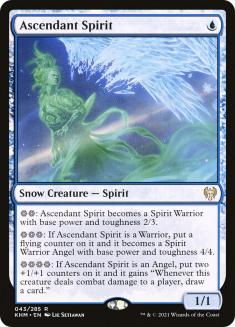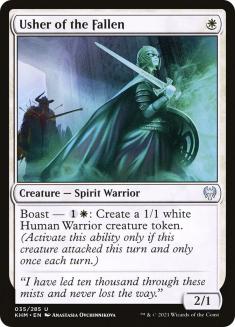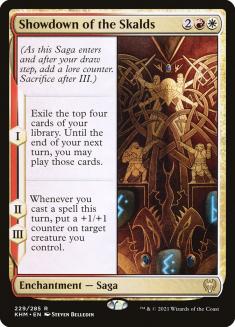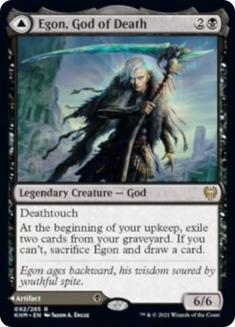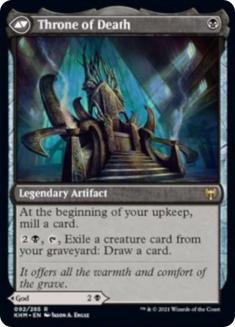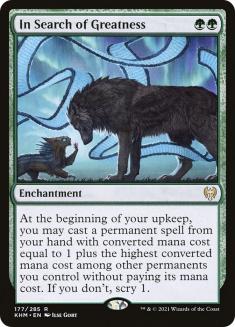On Wednesday, the Kaldheim Early Access streamer event took place — an event where some influential players, streamers, and content creators had the chance to play with the new cards before they were officially released. I spent both days playing this event and got the chance to try out many of the new cards and strategies, so in this article I’ve highlighted the ones that I think have the most potential moving forward (either that I played myself or that were impressive when played against me).
It’s important to note that games in the Early Access streamer event don’t necessarily reflect what’s actually going to happen with the metagame. First, they’re Best of One, which naturally gives some decks a big artificial advantage, but most importantly they’re full of people trying out the new cards. If you play a deck like Dimir Rogues in the Early Access streamer event you’ll be booed out of the room and people mostly eschew interaction in favor of just maximizing their own thing, so creatures die less and combinations are easier to assemble. That said, even if you don’t take any results at face value, you can still use the event to try out the new cards and see how they actually work in practice.
1. Faceless Haven
I expected Faceless Haven to be good. It is a colorless creature-land, after all, and those have almost always been good, but it turned out to be much better than I expected. 4/3 is a huge body, four is a lot of damage, and three mana to activate is not that much, especially given that it has vigilance, which means you often get to use it after attacking. In the early access event, I saw many games where someone cast a sweeper and then just died to two Faceless Haven attacks.
I think this card could potentially singlehandedly revitalize mono-colored aggressive decks — it’s that strong. Before Kaldheim, there wasn’t really a compelling reason to play Mono-Red Aggro over Gruul Adventures, for example, but now there is. This isn’t to say that Mono-Red Aggro will necessarily be better than Gruul Adventures — it might not be — but it’s possible that both decks can now coexist rather than one cannibalizing the other (and it’s also possible that Mono-Red just becomes better).
It’s also worth mentioning that Faceless Haven is a changeling, which has applications that are easy to forget. You can, for example, pump it with Fervent Champion or tap it for mana and get a Treasure from Magda, Brazen Outlaw. I even had a game where I gave it lifelink with Archon of Sun’s Grace!
Creatures (27)
- 4 Robber of the Rich
- 4 Fervent Champion
- 4 Bonecrusher Giant
- 2 Torbran, Thane of Red Fell
- 2 Rimrock Knight
- 4 Anax, Hardened in the Forge
- 2 Magda, Brazen Outlaw
- 2 Goldspan Dragon
- 2 Dragonkin Berserker
- 1 Birgi, God of Storytelling
Lands (23)
Spells (10)
Sideboard

Tundra Fumarole in particular is incredibly good with Faceless Haven, as it lets you remove a blocker and use the mana to activate it (since it’s a snow sorcery, you get snow mana).
The two-drops in this deck are a bit all over the place, but I think they’re all worth trying. Robber of the Rich is still probably the best, but Magda and Dragonkin Berserker could both be very good as well, so I think it’s worth trying a mix earlier on (plus Magda is legendary so you can’t really play more than two in a deck like this). I also like that the mana from Tundra Fumarole lets you activate Dragonkin Berserker later in the game.
2. Blessing of Frost
Another card that has impressed me was Blessing of Frost. Obviously there will be moments in which this does nothing, but I’d say the average is getting four extra damage in and drawing two cards (while leaving a huge battlefield left), and sometimes you get much more than that as it allows you to attack with creatures that previously couldn’t.
For example, imagine a scenario in which you have two 2/2s and your opponent has a 3/3. Normally, you’re not going to attack, so you’re dealing zero damage. If you have a maxed-out Blessing of Frost, you get two 4/4s and draw two cards, and since you can now attack, the Blessing is actually responsible for eight damage on top of turning your useless 2/2s into real creatures for the rest of the game.
I think it’s possible that a Selesnya version of the deck is good, since it pairs well with Conclave Mentor and Luminarch Aspirant is quite the two-drop, but the mana becomes a bit awkward if you’re trying to support both snow and an aggressive two-colored deck, as you start having too many lands that enter the battlefield tapped or turns where you can’t cast Blessing for four. I think a base-white version could be worth exploring, but right now I’ve been liking Mono-Green just fine.
Creatures (28)
- 2 Scavenging Ooze
- 2 Questing Beast
- 1 Wildborn Preserver
- 4 Stonecoil Serpent
- 1 Yorvo, Lord of Garenbrig
- 4 Syr Faren, the Hengehammer
- 2 Nessian Hornbeetle
- 2 Gemrazer
- 2 Swarm Shambler
- 4 Kazandu Mammoth
- 4 Old-Growth Troll
Lands (23)
Spells (9)
Sideboard

Again the number of two-drops is probably a bit off, but I don’t know for sure which one is better so I’ve gone with a mix, since they seem of similar power level to me and they all scale badly in multiples anyway.
Gemrazer has fallen out of favor a bit, but I think Sagas will be a bigger part of the metagame now, so I like having the added utility.
3. Snow
Jorn, God of Winter, Graven Lore, and Blood on the Snow all impressed me as a package deal. I wasn’t very sold on Jorn early on, since it’s relatively unreliable as a creature, but the effect really is incredibly strong if it works. A very common play pattern is to cast it on Turn 3, clear their blocker on Turn 4, and get all your mana back alongside a 3/3 blocker (since it untapped itself).
Jorn is not hard to kill, but it can also not be trivial for some decks. It does survive Bonecrusher Giant and is immune to the front side of Bloodchief’s Thirst. If they can’t kill it, then you’re going to get a lot of free wins by just doubling your mana early on. If they can kill it, you haven’t lost much because Jorn is bound to come back later in the game for free once you cast Kaldring, the Rimestaff.
Blood on the Snow feels expensive sometimes but its ceiling is extremely high. At first I thought the combo with Shipwreck Dowser was sort of a meme, but it played out much better in practice since it lets you lock aggro decks out of the game or rebuy a draw spell or a counterspell against the other decks. Dowser is also a good card to pair with Jorn since it’s a card you can cast and tap out for before you attack, and then once you do, you get to cast whatever it is you brought back.
Creatures (8)
Planeswalkers (1)
Lands (26)
Spells (25)

The thing that I’m currently trying to improve is the ability to use Kaldring, the Rimestaff early on. Having self-mill would be ideal, since you can then cast lands, but I don’t know if I want to play any self-mill card at all. Right now, I’m trying out two Faceless Haven as a sort-of-card-you-can-recur-sometimes, as well as two Priest of the Haunted Edge as early blockers that can be recurred after they kill something.
Obviously the numbers in this deck aren’t going to be correct right now, but it really did seem like a very powerful strategy that was worth exploring more.
4. Esika’s Chariot
Esika’s Chariot has the undisputed best art in all of Magic, but some games in the Early Access streamer event showed it can be more than just a pretty face. If you have no other synergies, you’re getting two 2/2s that can team up to become an extra 4/4, which is certainly not bad as far as defensive value goes, but if you attack just once you start generating extra tokens and then the card becomes quite good. The key to making it work, however, seems to be to generate more powerful tokens than 2/2s (namely Angels). If you can curve Esika’s Chariot into an Angel-generating card, either Firja’s Retribution or Starnheim Unleashed, it’s very hard to lose the game.
My best-performing Esika’s Chariot deck was Abzan Control with Yorion, Sky Nomad, which I think is a good fit because Esika’s Chariot is a very good card to blink and because this deck naturally wants to play Firja’s Retribution. You could explore with other types of tokens a bit, such as Food or Treasure, but I think copying Cats and Angels for the time being should be good enough.
Creatures (8)
Lands (24)
Spells (28)

I’m also trying out Battle for Bretagard in this deck. It’s not the best card to blink with Yorion – Omen of the Sun is much better – but if you ever manage to copy an Angel or even a Cat token, then it’s a lot of value for three mana.
5. Ascendant Spirit
When I first saw Ascendant Spirit, I thought it was just a bad card. After playing with it more, I’m actually not so sure. This might be a function of people not playing enough removal in the Early Access streamer event, but it’s surprisingly easy to just kill people with this card. If they can’t deal with it, it attacks for two, then four, then six, then eight; all you need to kill them on Turn 5 is this card and four snow lands (keeping in mind that the last ability can be activated multiple times).
The good thing is that it actually outscales red removal. For example, imagine you’re on the play and you cast this against Gruul Adventures. On Turn 2, it becomes a 2/3 — which means it’s immune to Stomp. They can cast Scorching Dragonfire or Fire Prophecy at this point, but most Gruul Adventures players don’t even maindeck them, so at this point this card is safe. Then, on Turn 3, it becomes a 4/4 flyer — which means it’s now safe from even those removal spells. On Turn 4, it becomes a 6/6 flyer — which mean it’s now safe from two copies of Stomp, before they even have the chance to hit four mana.
Then, on Turn 5, they’re dead!
This is not at all an unrealistic scenario and all it asks of you is that you have Ascendant Spirit and lands, and that you win the die roll. Of course you can do it if you don’t win the die roll but then Turn 5 might not be good enough if you’re spending all your mana every turn. On the play it almost certainly will be.
I think the ceiling on this card is high enough that it’s worth trying. This is what I had:
Creatures (22)
- 2 Hypnotic Sprite
- 4 Brazen Borrower
- 2 Voracious Greatshark
- 2 Alrund, God of the Cosmos
- 4 Ascendant Spirit
- 4 Cosima, God of the Voyage
- 4 Frost Augur
Lands (27)
Spells (11)

This was my attempt at an aggro-control style of deck, the idea being that, if they do something, you react to it, and, if they don’t, you pump your Ascendant Spirit (unless of course you have reason to believe you can just kill them with it).
The Cosima, God of the Voyage / Frost Augur interaction is a bit weird since Cosima pushes you to play Fabled Passage and Frost Augur pushes you to play Snow-Covered Islands instead, but I think Cosima wins that particular exchange and the cards interact well outside of that since Frost Augur is a cheap creature to crew The Omenkeel.
I thought this deck had potential as well, and will continue working on it.
6. Usher of the Fallen
Usher the Fallen is a very strong addition to any Mono-White Aggro deck — in fact, it might be the best Savannah Lions ever outside of perhaps Kytheon, Hero of Akros. Is it good enough to turn Mono-White Aggro into a Tier 1 deck? Honestly, probably not, but the deck did seem pretty good, so there’s a chance. Here’s where I’m at:
Creatures (29)
- 3 Giant Killer
- 4 Seasoned Hallowblade
- 4 Selfless Savior
- 4 Skyclave Apparition
- 4 Luminarch Aspirant
- 2 Halvar, God of Battle
- 4 Clarion Spirit
- 4 Usher of the Fallen
Planeswalkers (2)
Lands (23)
Spells (6)

Clarion Spirit is another addition to the deck, and while it’s not easy to trigger repeatedly you really don’t need to trigger it many times for it to be good (don’t forget that the tokens have flying).
Showdown of the Skalds is a very powerful card but I don’t know what the best home for it is. I don’t think it’s very good in a traditional control deck, since you have too many reactive cards that you won’t be able to play and you don’t care that much about the +1/+1 counters, so ideally you’re playing it in an aggressive deck full of cheap cards, but the problem is that these aggressive decks full of cheap cards can’t necessarily support a multicolored card. Mono-White Aggro and Mono-Red Aggro have traditionally been very “color-heavy” decks and I don’t know if the mana can support a Boros Aggro deck at all.
My inclination is that it might be possible to be white with a light red splash, or red with a light white splash, but not flat-out Boros. Alternatively, you can play Mardu Knights and hope that Tournament Grounds will do the fixing for you:
Creatures (26)
- 4 Smitten Swordmaster
- 4 Inspiring Veteran
- 4 Venerable Knight
- 4 Worthy Knight
- 4 Fervent Champion
- 4 Stormfist Crusader
- 2 General Kudro of Drannith
Lands (24)
Spells (10)

7. Egon, God of Death // Throne of Death
We knew Rakdos was going to be revitalized with Kaldheim, since it got its own Pathway, but some of the new cards are also pretty good. Throne of Death, in particular, stood out as a good Turn 1 milling enabler that we didn’t have before, while also being a milling payoff on both sides.
Other than Egon, God of Death, the deck also got Valki, God of Lies as a powerful two-drop and late-game insurance, as well as Immersturm Predator, which is a good sacrifice outlet alongside Woe Strider. I don’t know if this is the best way to build the deck (you can choose to rely even more on the graveyard or more on the sacrifice synergies) but I am quite sure that there will be a powerful build of Rakdos Midrange in Kaldheim Standard.
Creatures (23)
- 4 Bonecrusher Giant
- 4 Woe Strider
- 3 Mire Triton
- 3 Kroxa, Titan of Death's Hunger
- 2 Valki, God of Lies
- 4 Egon, God of Death
- 3 Immersturm Predator
Lands (21)
Spells (16)
Sideboard

8. In Search of Greatness
When In Search of Greatness was previewed, my impression was that it was going to be impossible to evaluate it without having played with it. I thought that it was the kind of card that you had to experience to know, but that, once I played with it a couple of times, it would become painfully obvious whether it was good or not.
I was wrong. I played a lot of games with it, in many different shells, and I still have no idea if it’s good. Like, no idea at all. It could be extremely unplayable or the best card in the set and neither would surprise me at this point.
This means, of course, that we have to keep trying it; any card that could be the best card in the set has to be tried until we can figure out how good it actually is. These are the two most interesting decks I tried it on:
Creatures (21)
- 1 Questing Beast
- 1 Wicked Wolf
- 4 Bonecrusher Giant
- 4 Setessan Champion
- 1 Klothys, God of Destiny
- 3 Nessian Wanderer
- 1 Keruga, the Macrosage
- 1 Kogla, the Titan Ape
- 3 Yorion, Sky Nomad
- 1 Terror of the Peaks
- 1 Vorinclex, Monstrous Raider
Lands (32)
Spells (27)

Creatures (14)
- 1 Wicked Wolf
- 3 Setessan Champion
- 2 Archon of Sun's Grace
- 1 Dream Trawler
- 2 Nessian Wanderer
- 1 Keruga, the Macrosage
- 1 Kogla, the Titan Ape
- 1 Yorion, Sky Nomad
- 2 Skyclave Apparition
Lands (23)
Spells (23)

I think Yorion is a natural fit with In Search of Greatness, since both cards want you to maximize permanents. I also discovered two interesting synergies:
- In Search of Greatness works very well with flash cards. If you cast a Turn 2 In Search of Greatness, you can stack the trigger on Turn 3 and cast either Omen of the Sea or Omen of the Forge, which lets you immediately put a three-drop onto the battlefield with In Search of Greatness. At this point, your In Search of Greatness was essentially free, and you can cast a three-mana card on Turn 3 even if you only have two lands.
- In Search of Greatness works very well with Sagas (or very badly, depending on what you want, but usually well) because you get two triggers at once. If you use it to put Elspeth Conquers Death onto the battlefield, for example, you get one trigger when it enters the battlefield and then another immediately when you draw a card.
Both the decks I liked used Enigmatic Incarnation, as that’s sort of a pet card I wanted to try and it does go quite well with a lot of permanents that we naturally want to play, but I don’t know whether it’s good enough or not at this point (as I said, this card is going to take a lot more experimenting to figure out).
Overall, Kaldheim seemed to be a very interesting set and many of the cards showed a lot of promise. Now we just have to hope they can match up to the Throne of Eldraine cards in a competitive environment.

